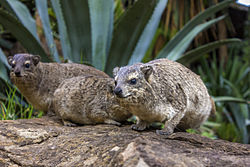Rock hyrax
| Rock hyrax | |
|---|---|
 |
|
| A rock hyrax family | |
| Scientific classification | |
| Kingdom: | Animalia |
| Phylum: | Chordata |
| Class: | Mammalia |
| Order: | Hyracoidea |
| Family: | Procaviidae |
| Genus: |
Procavia Storr, 1780 |
| Species: | P. capensis |
| Binomial name | |
|
Procavia capensis (Pallas, 1766) |
|
 |
|
| Rock hyrax range | |
The rock hyrax (Procavia capensis), also called rock badger and Cape hyrax, is commonly referred to in South African English as the dassie. It is one of the four living species of the order Hyracoidea, and the only living species in the genus Procavia. Like all hyraxes, it is a medium-sized (~4 kg) terrestrial mammal, superficially resembling a guinea pig with short ears and tail. The closest living relatives to hyraxes are the modern-day elephants and sirenians. The rock hyrax is found across Africa and the Middle East in habitats with rock crevices into which it escapes from predators. It is the only extant terrestrial afrotherian in the Middle East. Hyraxes typically live in groups of 10–80 animals, and forage as a group. They have been reported to use sentries: one or more animals take up position on a vantage point and issue alarm calls on the approach of predators.
The rock hyrax has incomplete thermoregulation and is most active in the morning and evening, although its activity pattern varies substantially with season and climate.
Over most of its range, the rock hyrax is not endangered, and in some areas is considered a minor pest. In Ethiopia, Israel and Jordan, it is a reservoir of the leishmaniasis parasite.
The rock hyrax is squat and heavily built, adults reaching a length of 50 cm (20 in) and weighing around 4 kg (8.8 lb), with a slight sexual dimorphism, males being approximately 10% heavier than females. Their fur is thick and grey-brown, although this varies strongly between different environments: from dark brown in wetter habitats, to light gray in desert living individuals. Hyrax size (as measured by skull length and humerus diameter) is correlated to precipitation, probably because of the effect on preferred hyrax forage.
...
Wikipedia

